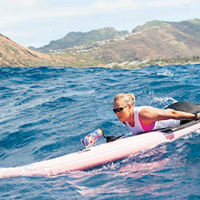
The marine science education efforts of CRDG’s Kanesa Duncan continued to expand this year through collaborations with the University of Hawai’i Sea Grant College Program, the Hawai’i Institute of Marine Biology (HIMB), Maui Community College (MCC), and others. In her first full year as director of the Center of Excellence for Marine Science Education, one of four centers of excellence established by the UH Sea Grant College Program, Duncan coordinated two programs for the biennial School of Ocean and Earth Science and Technology (SOEST) Open House. The Ocean Literacy Poster Contest, sponsored by Maui Jim Sunglasses, encouraged teachers and students in grades K–8 to get involved not only in learning about the value of the ocean to all of us, but also in communicating that message to others. The other activity highlighted the center’s work with Sea Grant research assistants, all of whom participate in a CRDG-facilitated training that helps them develop outreach programs to share cutting-edge marine science research with K–12 students and teachers and with the community.
Another major thrust of the center’s work is providing inservice professional development for teachers in marine science, and this year three new courses were developed.
In partnership with Judy Lemus of HIMB and College of Education doctoral student Kaleo Veary, Duncan adapted a course on communicating ocean sciences developed at the Center of Ocean Science Education Excellence (COSEE) in California for Hawai’i, incorporating material on both the local environment and traditional knowledge. Duncan, Lemus, and Veary co-taught the course for graduate students in SOEST in the fall of 2009 and have worked with faculty at Maui Community College to create an undergraduate course to be taught in 2010.
 The two other courses are part of CRDG’s Teaching Science as Inquiry (TSI) series. A new TSI course on physical oceanography was piloted this summer as part of the program to provide practicing elementary, middle, and high school science and mathematics teachers with opportunities to increase their knowledge and understanding of recent developments in science, technology, engineering, and mathematics funded by the Hawai’i legislature. It will eventually become part of the comprehensive marine science educator course that is the focus of an upcoming three-year project.
The two other courses are part of CRDG’s Teaching Science as Inquiry (TSI) series. A new TSI course on physical oceanography was piloted this summer as part of the program to provide practicing elementary, middle, and high school science and mathematics teachers with opportunities to increase their knowledge and understanding of recent developments in science, technology, engineering, and mathematics funded by the Hawai’i legislature. It will eventually become part of the comprehensive marine science educator course that is the focus of an upcoming three-year project.
The other new TSI course was a collaboration with the Maui Economic Development Board (MEDB) that focused on energy sustainability. The jam-packed course combined science, ecology, and social science as teachers learned what energy is, and how utilities produce, store, and distribute energy in our communities. A new grant will allow Duncan to modify the course for other islands and teach courses on O’ahu, Hawai’i, and Kaua’i in 2010.

 The love of the ocean that Kanesa Duncan brings to her work is evident in her personal time as well, where she is the seventime winner and women’s record holder of the Moloka’i Challenge, a Moloka’i to O’ahu paddleboard race. Sponsored by Rainbow Sandals and Maui Jim sunglasses, the Moloka’i Challenge is what is known as unlimited traditional style paddleboard. This style involves laying on very large boards that are designed to catch open ocean waves. “I get to combine a lot of what I do for work with what I do for pleasure, as I educate people about the marine environment,” Duncan said. She started paddleboarding nine years ago, and entered the Moloka’i Challenge from her first year. She says paddleboarding is a “wonderful combination of swimming and surfing out in the open ocean. There are days when the water and the sky are so beautiful, it just makes you happy.”
The love of the ocean that Kanesa Duncan brings to her work is evident in her personal time as well, where she is the seventime winner and women’s record holder of the Moloka’i Challenge, a Moloka’i to O’ahu paddleboard race. Sponsored by Rainbow Sandals and Maui Jim sunglasses, the Moloka’i Challenge is what is known as unlimited traditional style paddleboard. This style involves laying on very large boards that are designed to catch open ocean waves. “I get to combine a lot of what I do for work with what I do for pleasure, as I educate people about the marine environment,” Duncan said. She started paddleboarding nine years ago, and entered the Moloka’i Challenge from her first year. She says paddleboarding is a “wonderful combination of swimming and surfing out in the open ocean. There are days when the water and the sky are so beautiful, it just makes you happy.”
